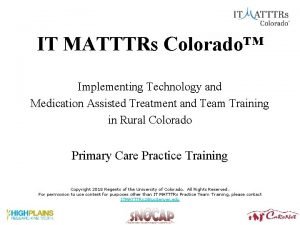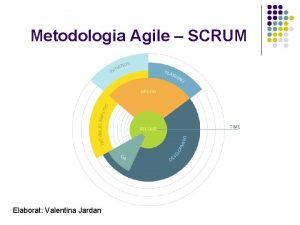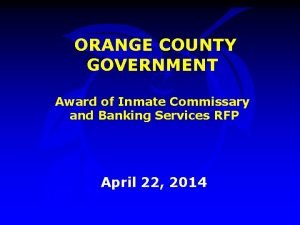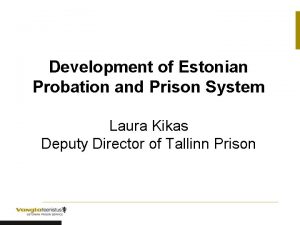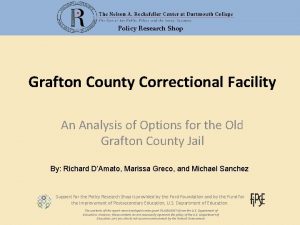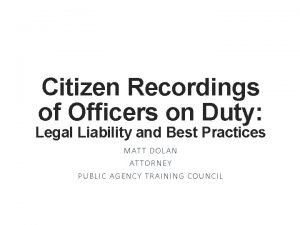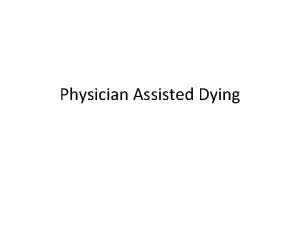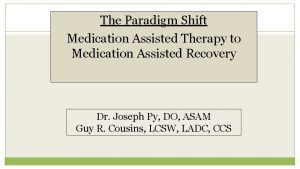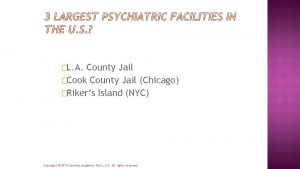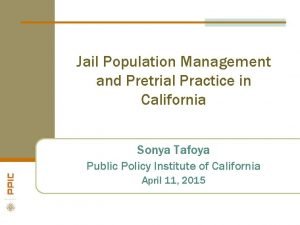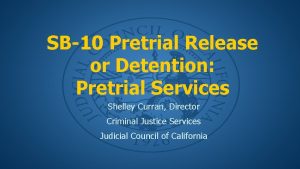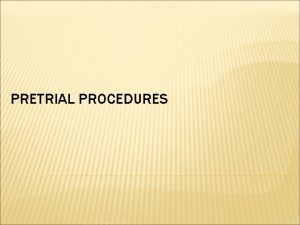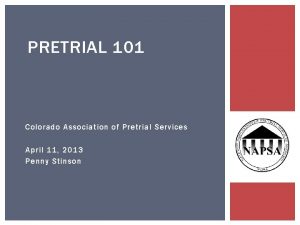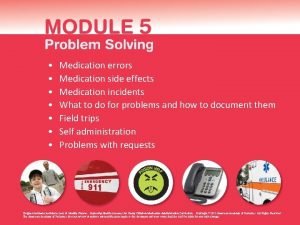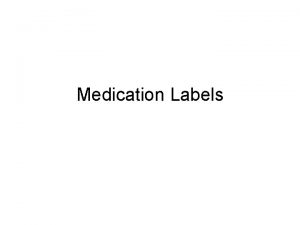Pretrial Medication Assisted Treatment for Jail Populations Steve





















- Slides: 21

Pre-trial Medication Assisted Treatment for Jail Populations Steve Keller & Andy Klein Advocates for Human Potential, Inc. 1

Housekeeping: Functions 9/18/2020 2

Housekeeping: Communication 9/18/2020 3

Pre-trial Medication Assisted Treatment for Jail Populations Moderator Stephen Keller TTA Coordinator, RSAT-TTA 9/18/2020 4

Learning Objectives During this webinar participants will learn about: • Understand the importance of pretrial diversion for individuals with opioid use disorders. • Identify treatment options, specifically medication assisted treatment, for pretrial diversion programs. • Explain the types of programming that make for a successful pretrial program, including peer-led programming and therapeutic communities. 9/18/2020 5

Why Pretrial? • Approximately 750, 000 in nation’s jails. • Almost 500, 000 are there awaiting trial. • However, because the average stay of pretrial detainees is much shorter than those sentenced to jail, the number of pretrial detainees that pass through the nation’s jails are over 10 million a year.

Why Pretrial? • Like those sentenced to jail, the majority of these 10 million detainees have substance use disorders and, in many jurisdictions, many of these suffer from opioid use disorders. • The last BJS study that looked at jail populations found 12 to 20% were heroin/opioid users and that was before the current opioid epidemic.

Why Pretrial? No response to the current epidemic can succeed if we miss this ideal opportunity to respond to persons with opioid use disorders. It is estimate that more than a quarter of all persons with opioid use disorders become involved in the criminal justice system. We know that the criminal justice system is the single largest referral source for drug treatment in the nation. The several weeks persons are in jail awaiting return to court for trial or case resolution offer us an unique venue for initiating treatment and MAT.

Role of RSAT And RSAT can play a tremendous role on multiple levels… ØSupport from correctional officers/staff ØSupport groups, staff and peer-led ØTreatment

e. g. Essex County, Massachusetts Jail

e. g. Essex County, Massachusetts Jail • Essex County has the highest per capita drug overdose death rate in the Commonwealth of Massachusetts • flood of individuals with opioid use disorders both before and after trial. • Diversion program through drug court clients can be referred to detoxification center • Former Sheriff founded center

Essex County Jail Detox Unit • 42 -bed units for men & women • Facility is separated from both sentenced individuals and other pretrial detainees not referred to the detox unit • Sheriff and RSAT (TRAC) drug treatment staff realized that detoxification is not treatment • 28 -Day Detox Program

28 Day Detox Program The Program: 1) Safe, humane, medically supervised detox as appropriate 2) Introduction to individual and group treatment for SUDs, including: • Peer-led recovery support by sentenced RSAT(TRAC) clients nearing the end of their RSAT program in the RSAT unit of the jail

28 Day Detox Program, cont. 3) Clinical and substance abuse evaluation, including eligibility for MAT, specifically injectable naltrexone before release 4) Drug and MAT education 5) If appropriate and if client opts for it, oral dose of naltrexone to test for allergic reaction 6) Injection of naltrexone before return to court 7) Development of continuing support and treatment plan in the community, including Medicaid enrollment or insurance negotiation, and linkage to prescribing physician as needed 8) Report to the court of plan to be implemented if approved by the judge and non-custodial disposition imposed 9) If the client elects MAT, a jail case manager will continue to work with them to ensure follow up in the community on a voluntary basis

How do detainees enter the detox unit program? 1) The arraignment judge, based on nature of charges, defendant’s criminal history, drug history, continues the case for 28 days and asks the detainee to be sent to the detox unit • The judge may indicate to the defendant, defense attorney and the prosecutor that the court will be more disposed to consider noncustodial alternatives upon a guilty finding or plea if he participates in the 28 day program 2) Drug court coordinator works closely with jail staff to identify an entering detainee as a good candidate for the program • Judge may make accommodations (i. e. change court date, pre -hearing communication with attorneys) if participation in the 28 -day program is in their best interest

How RSAT can help? RSAT RESOURCES → Expert staff support: • Incl. counselors, clinicians, transition coordinators, support staff, experienced correctional officers trained in motivational interviewing, and more…. → RSAT Program Components: • MAT education, group/individual counseling initiation, aftercare planning, referral network post -release → Controlled Dissemination of medication

How RSAT can help? → Identifying eligible and appropriate candidates → Same clinical evaluation, medical procedures → Same briefing/education about role of MAT in recovery → Introduce counseling, support, and encouragement → Provision of peer support by appropriate RSAT clients → Same referral base, transition planning for postrelease treatment/medication → Same in/out case managers

Questions? Type your question in the Q&A box on your computer screen. Speaker Contact Info Steve Keller Skeller@ahpnet. com Andy Klein Aklein@ahpnet. com 9/18/2020 18

Certificate of Attendance Download now! 9/18/2020 19

Continuing Education Hour (CEU Certificate) • 1 NAADAC CEH • Pass 10 -question quiz with 7 correct answers • Receive certificate immediately 9/18/2020 20

RSAT TTA Center For more information on RSAT training and technical assistance, visit http: //www. rsat-tta. com/Home or e-mail Stephen Keller, RSAT TTA Coordinator, at skeller@ahpnet. com 9/18/2020 21
 Medication assisted treatment colorado
Medication assisted treatment colorado San diego pretrial services
San diego pretrial services Ediscovery bexar county
Ediscovery bexar county Ronald wayne biography
Ronald wayne biography Jail industries
Jail industries Warren county ky jail commissary
Warren county ky jail commissary Asyndeton ap lang
Asyndeton ap lang Socrates letter from birmingham jail
Socrates letter from birmingham jail Metodoligia scrum
Metodoligia scrum Score jail commissary
Score jail commissary Birmingham city jail warrants
Birmingham city jail warrants Laura giraldo jail
Laura giraldo jail The night thoreau spent in jail characters
The night thoreau spent in jail characters Cherry valance
Cherry valance Grafton county jail
Grafton county jail Letter from birmingham jail summary
Letter from birmingham jail summary Jail container
Jail container From yale to jail
From yale to jail Letter from birmingham jail mla citation
Letter from birmingham jail mla citation Get out of jail free card
Get out of jail free card Malcolm x
Malcolm x Siskiyou county jail inmates
Siskiyou county jail inmates
